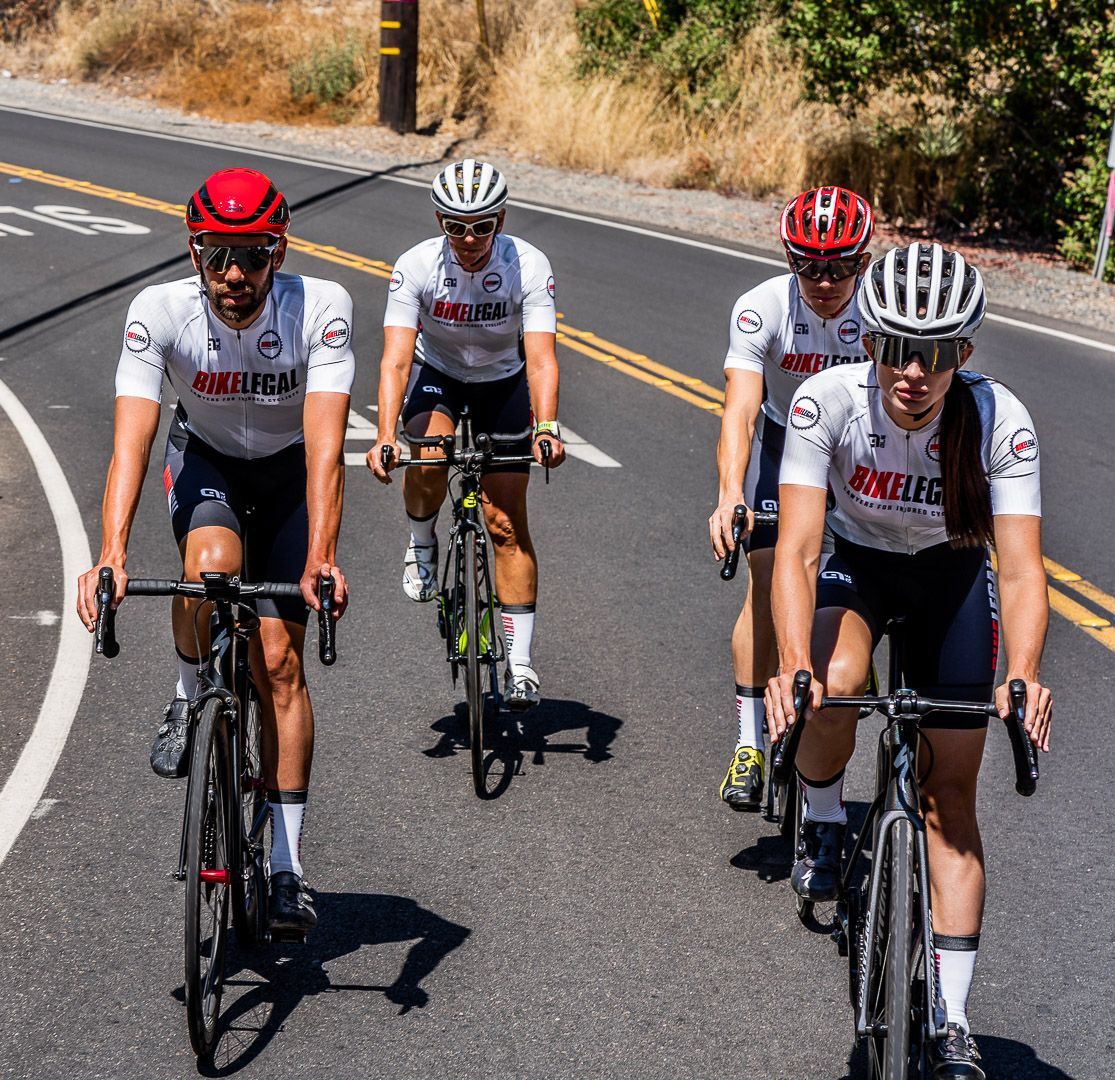Safe Distance to Pass a Cyclist: The 3 Feet and Other Safe Passing Bicycle Laws
Follow us on
social media!
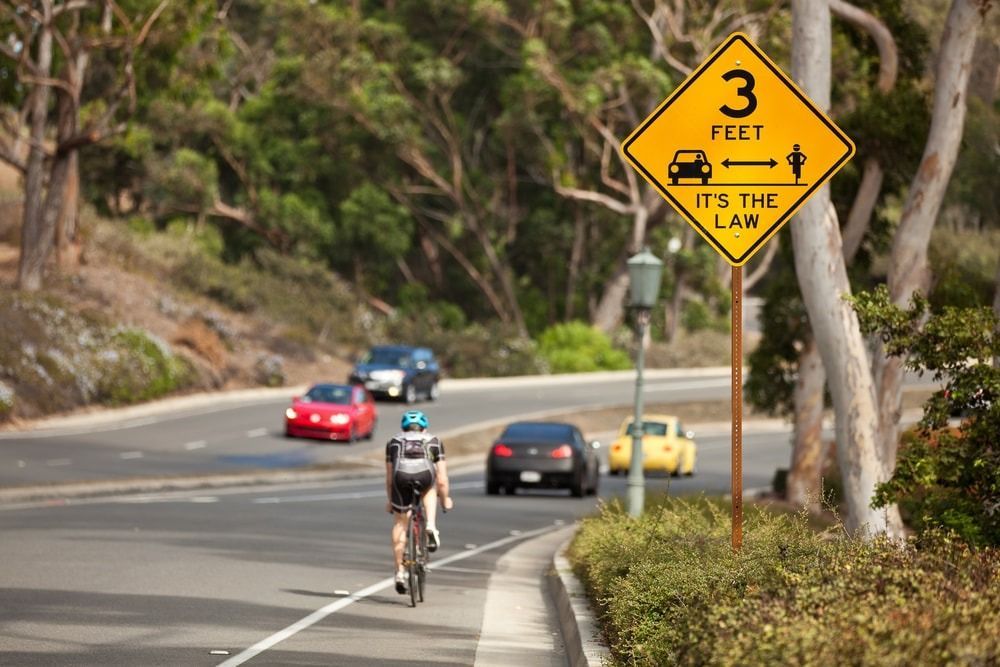
In 2022, U.S. motor vehicle crashes tragically claimed the lives of 1,105 cyclists, underscoring a dire need for stringent road safety laws. Among these protective measures is the "3-feet law," which mandates drivers to maintain a minimum three-foot distance when overtaking cyclists. This law serves as a crucial buffer, significantly reducing the risk of collisions and enhancing safety for cyclists.
This article delves into the 3-feet law, examining its importance, the challenges of its implementation, how it varies across states, and its pivotal role in fostering safer cycling conditions throughout the U.S.
- The 3-feet law demystified: What it is, why it matters, and how it varies across states.
- Beyond 3 feet: Exploring other laws designed to keep cyclists safe.
- A history lesson: How cycling safety laws have evolved over time.
- The California Omni bike law: A deep dive into a specific example.
- Close calls & buzzing: Why drivers do it and what you can do about it.
- The right distance? Is 3 feet enough? We'll look at the science and the debate.
- Pros & cons: The benefits and criticisms of safe passing laws.
- Around the globe: How the U.S. compares to other countries.
- Sharing with big rigs: Dealing with the challenges of sharing the road with large vehicles.
- Rules of the road: Can drivers cross lines to pass? When can't they pass at all?
- State-by-state guide: What's the law where you live?
- Enforcement and penalties: Challenges of enforcing safe passing laws.
- Tech to the rescue: Technology for drivers and cyclists that help make sharing the road safer.
- Building better roads: How urban planning can create safer cycling environments.
- Protected and Buffered bike lanes: Could these be the answer?
What is the 3 Feet Safe Passing Law?
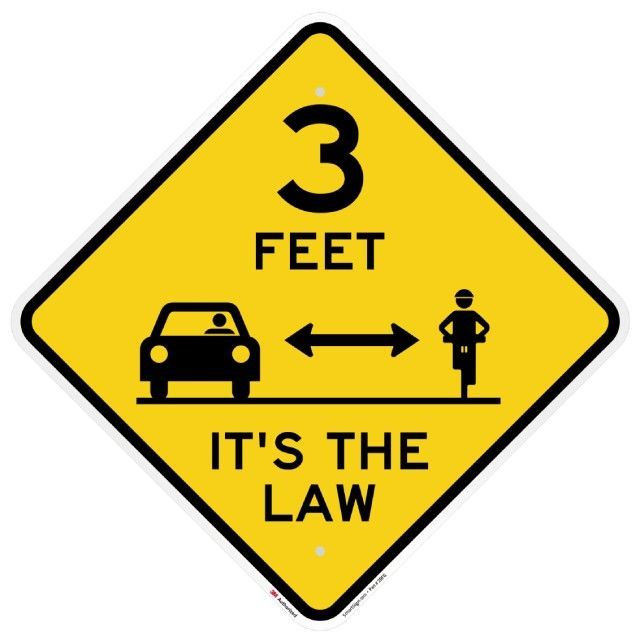
The "3-feet law" is a road safety regulation that requires motorists to maintain a minimum distance of three feet when passing a cyclist. This law is designed to provide cyclists with a safer space on the road, reducing the risk of accidents caused by close passing.
The three-foot buffer acts as a safety cushion, allowing cyclists enough room to maneuver in response to road conditions, obstacles, or unforeseen events, thereby enhancing their protection against potential collisions with vehicles.
This law is enacted in various jurisdictions, with the specifics of enforcement and penalties varying from place to place, reflecting an increasing recognition of cyclists' rights and the importance of their safety on public roads.
Why three feet should be the minimum for motorists to pass a bicyclist
- Reaction Time: Three feet provides cyclists with essential space to react and adjust their path in response to sudden obstacles, road irregularities, or unexpected maneuvers by vehicles.
- Wind Blast Reduction: When vehicles pass cyclists at high speeds, they generate a wind blast that can destabilize the cyclist. A three-foot buffer reduces this effect, helping cyclists maintain control of their bike.
- Error Margin: Both drivers and cyclists are prone to momentary lapses in judgment or control. The three-foot rule offers a margin of error that can prevent these minor deviations from resulting in collisions.
- Visibility and Awareness: By institutionalizing a specific passing distance, the 3-feet law enhances driver awareness of the space cyclists need. This not only improves safety for cyclists but also educates drivers about coexisting safely with bicycles on the road.
- Legal Clarity and Enforcement: A clearly defined minimum passing distance simplifies enforcement of the law. It provides law enforcement with a tangible measurement, making it easier to identify and penalize unsafe passing.
- Consistency and Predictability: When drivers consistently give cyclists three feet of space, it creates a predictable road environment where cyclists feel safer and are more likely to use their bicycles, thereby promoting cycling as a viable and safe mode of transport.
Other Safe Passing Laws That Protect Cyclists
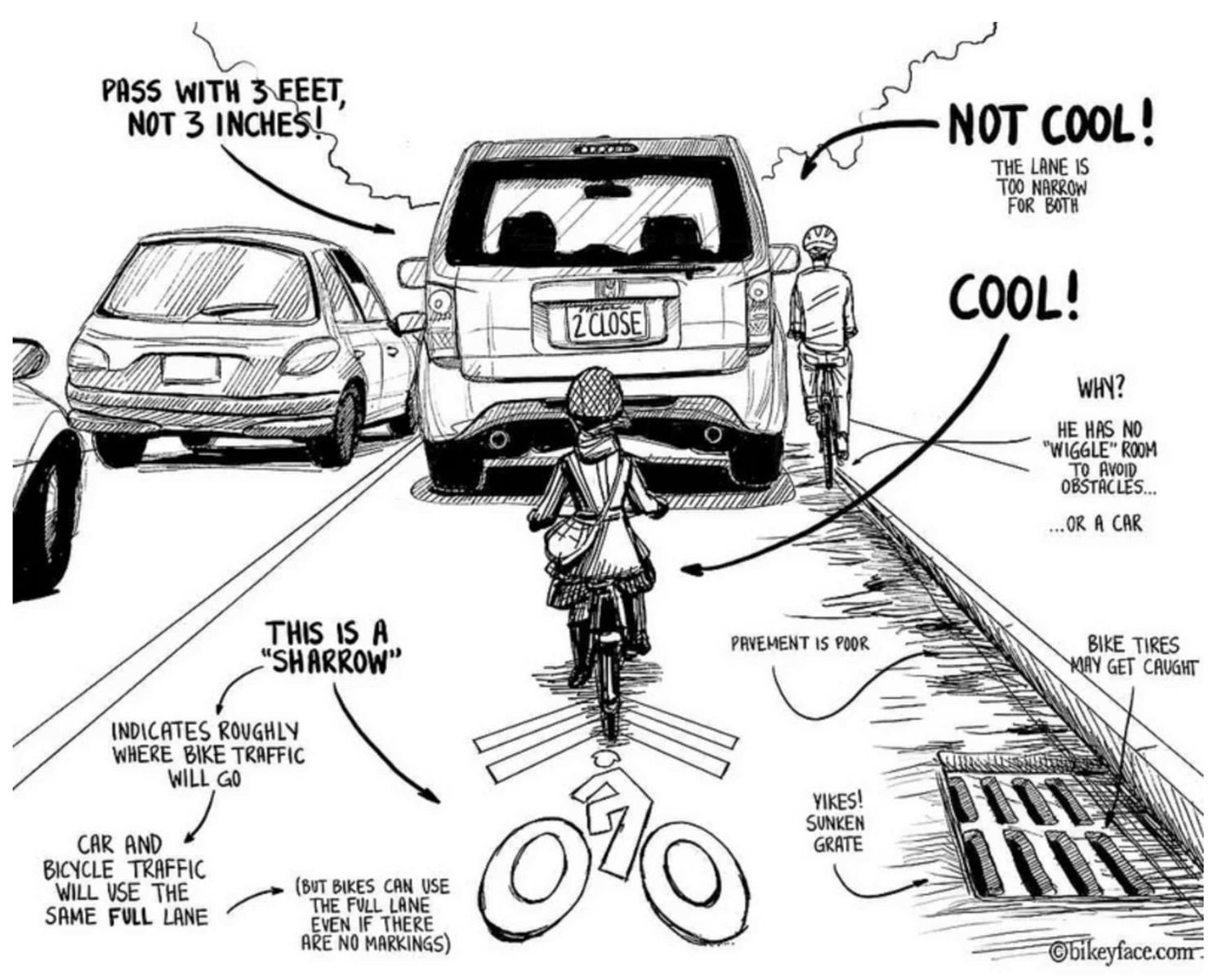
The 3-foot law isn't the only rule on the books designed to protect cyclists. Many states have gone a step further with even more robust safe passing laws. These laws aim to address the unique vulnerabilities cyclists face on the road.
Expanding the safety zone
Some states have opted for a more generous safety buffer, requiring drivers to give cyclists 4, 5, or even 6 feet of space when passing. This extra distance can be a game-changer, especially when:
- Speeds are high: At higher speeds, the wind blast from a passing vehicle is stronger and more destabilizing.
- The road is narrow: On tight roads, 3 feet might not be enough to create a safe passing zone.
- Visibility is poor: In low-light conditions or bad weather, extra space helps drivers see you more clearly.
Changing lanes for safety
In some areas, the law might require drivers to change lanes entirely when passing a cyclist, if it's safe to do so. This eliminates the risk of a close pass altogether, providing the ultimate level of protection.
The "Safe Distance" approach
Not all laws specify an exact distance. Some simply require drivers to pass at a "safe distance." While this might seem vague, it gives cyclists some legal backing if a driver passes too close for comfort.
Pro tip: Even in states with specific distance requirements, the "safe distance" principle often applies as an overarching rule. If 3 feet isn't safe in a particular situation (like on a narrow road with fast-moving traffic), a driver could still be held liable for passing too close.
A Historical Perspective on Safe Passing Laws in the US
The 3-foot law didn't just appear out of thin air. It's the result of a long journey in bicycle safety legislation, reflecting a growing recognition of cyclists' rights and vulnerabilities on the road.
Early days: Bicycles as "Vehicles"
The story starts way back in the late 19th century when the first bicycles hit the streets. Back then, these newfangled contraptions were often seen as a nuisance, with little legal protection for their riders.
Gradually, laws were passed recognizing bicycles as vehicles with the right to use the road. This was a major milestone, but it didn't guarantee safe interactions with cars.
The rise of safe passing laws
As cycling's popularity grew, so did the need for stronger safety measures. The 1970s and 80s saw a surge in advocacy for cyclists' rights, leading to the introduction of the first safe passing laws. These early laws often required a "safe distance" when passing, but the specifics were left open to interpretation.
The 3-feet law takes shape
The idea of a specific 3-foot passing distance gained traction in the 1990s and 2000s. This clear-cut rule offered a more enforceable standard for both cyclists and law enforcement.
Wisconsin became the first state to adopt the 3-foot law in 2006, and many other states soon followed suit. This marked a major turning point in the fight for cyclist safety.
The road ahead
Today, most states have some form of safe passing law, whether it's the 3-foot rule, a wider distance requirement, or a more general "safe distance" guideline. But the journey isn't over yet. Advocates continue to push for stronger protections and better enforcement to ensure all cyclists can ride safely and confidently.
The California Omni Bike Law: A Case Study
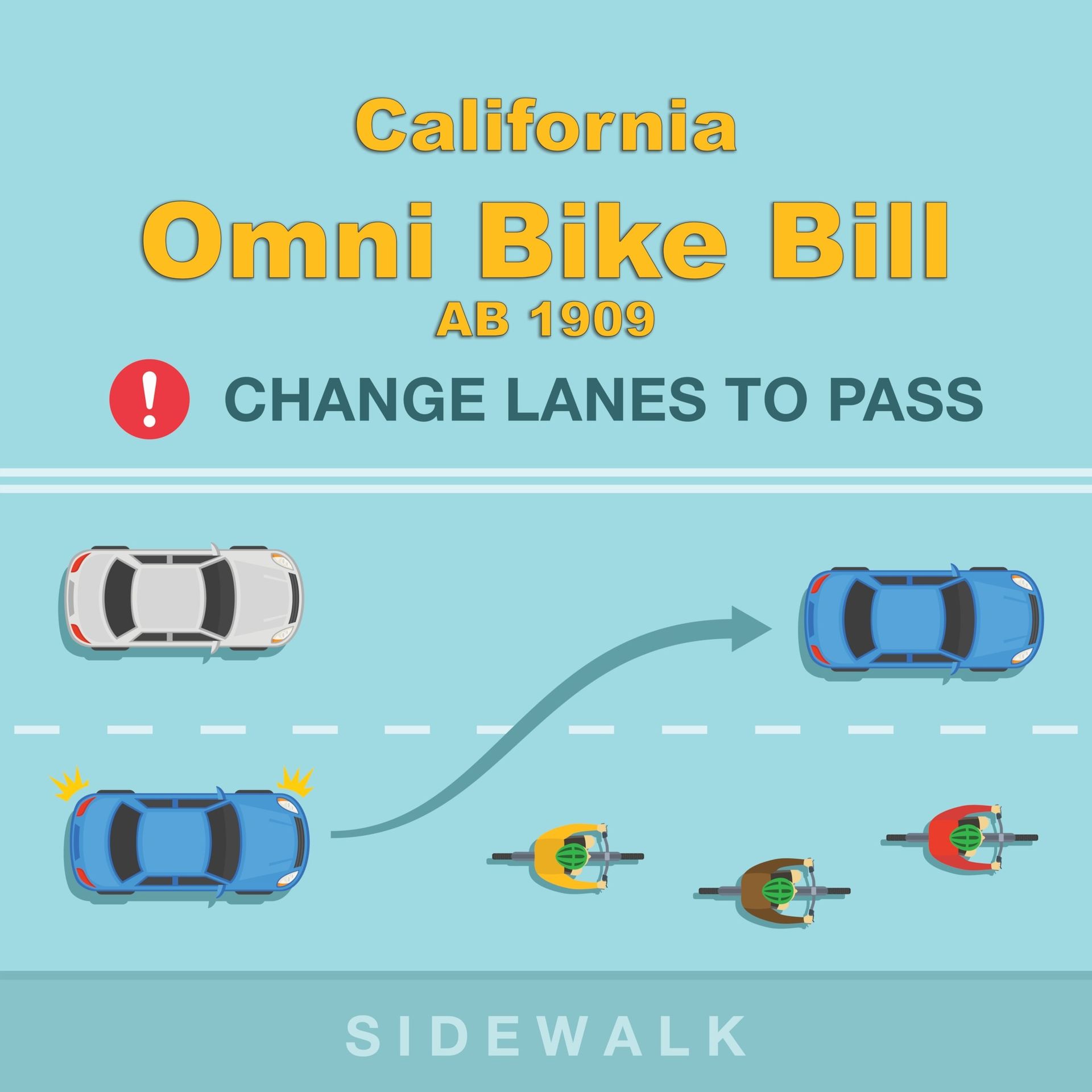
California, known for its car culture, took a major step forward in cyclist safety with the Omni Bike Law, which went into effect on January 1, 2024. This law not only reinforces the 3-foot rule but also introduces some key changes that are worth noting.
Key provisions of the Omni bike law
- Lane change requirement: When passing a cyclist, drivers are now required to change lanes if another lane is available, and the maneuver can be done safely. This eliminates the guesswork of the 3-foot rule and creates a much wider buffer zone.
"Buzzing" Cyclists: A Dangerous (and Illegal) Practice
What is Buzzing? Buzzing occurs when a motorist drives dangerously close to a cyclist, often at high speeds. This intentional aggressive maneuver significantly endangers the cyclist, creating a high-risk situation that can lead to accidents or cause the cyclist to lose control of their bicycle. The act of buzzing is usually deliberate, reflecting the motorist's frustration or disregard for the cyclist's right to share the road.
Why Do Drivers Buzz Cyclists? Several psychological factors contribute to why drivers engage in buzzing. In the enclosed space of a car, drivers can feel a sense of anonymity and impunity, believing they are unlikely to be caught for their actions. This anonymity can embolden drivers to take aggressive actions against cyclists, whom they may view as an out-group or "them" rather than "us" — the car drivers.
There is often a perceived division between motorists and cyclists, with some drivers feeling that cyclists do not belong on the roads or that they impede traffic flow. Additionally, some motorists harbor resentment towards cyclists over misconceptions about road usage and funding, such as the belief that cyclists do not pay their fair share for road maintenance, despite public funds being used for bike trails.
The Role of 3-Foot Laws in Combating Buzzing
The implementation of 3-foot laws serves several important functions in addressing the issue of illegal cyclist buzzing:
- Promoting Legal Accountability: By legally mandating a minimum distance of three feet between cars and bicycles, these laws create a clear standard that helps law enforcement officials identify and penalize offenders, thus reducing the perceived anonymity that motorists might feel.
- Enhancing Cyclist Safety: The 3-foot buffer provides cyclists with necessary space to maneuver safely, reducing the risk of collisions caused by close encounters with vehicles.
- Changing Social Norms: These laws help shift public perception by formally recognizing cyclists' rights to the road. Over time, this can help reduce animosity towards cyclists and encourage more respectful and considerate behavior from motorists.
- Reducing Cyclist Intimidation: By enforcing these safety measures, the laws aim to decrease the instances of cyclists feeling threatened or scared away from using roads, promoting a more inclusive environment for all road users.
Pro tip: If you're buzzed by a driver, try to get their license plate number and report it to the police. Even if they aren't caught right away, your report helps raise awareness of the issue and can lead to increased enforcement.
Is 3 Feet Really Enough? The Debate Over Safe Passing Distance
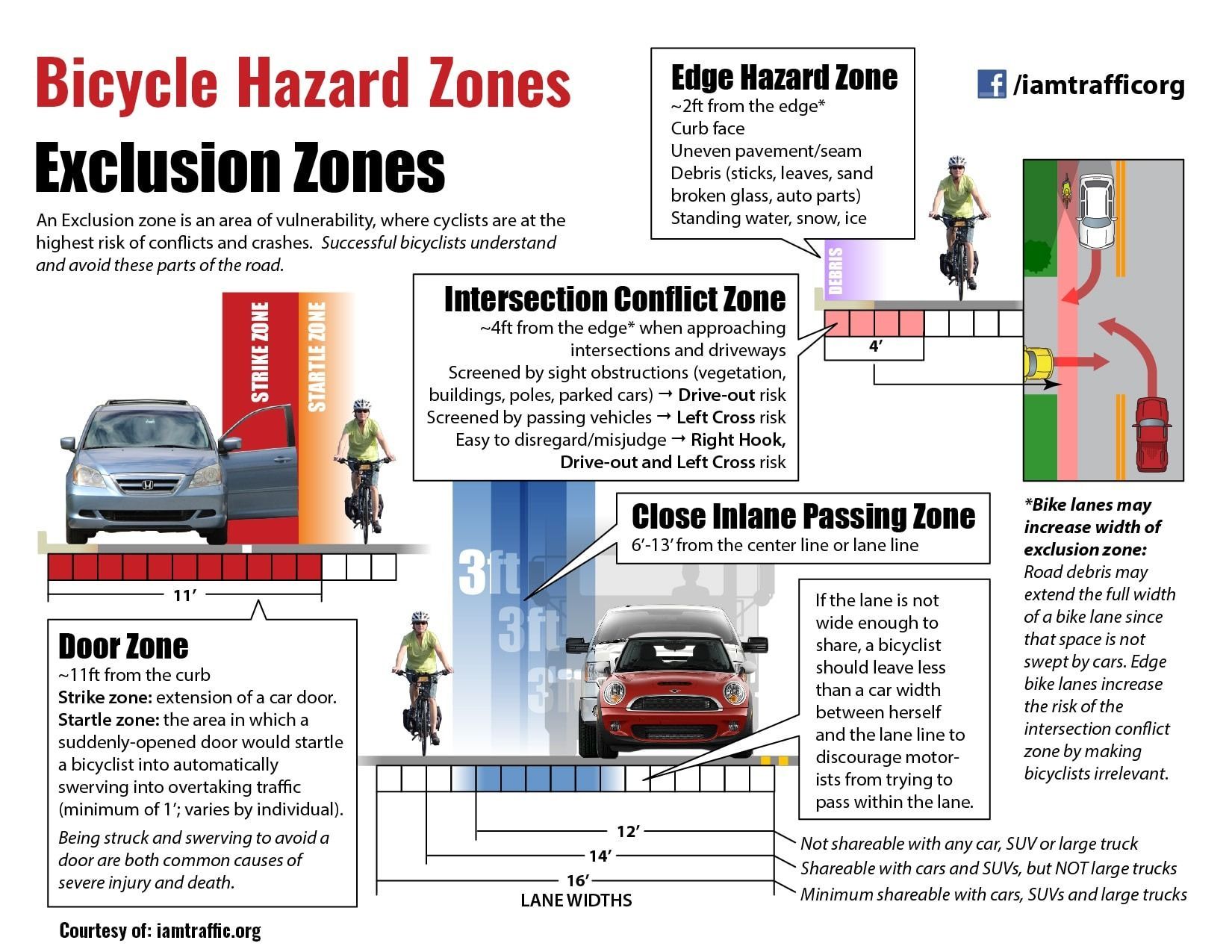
The 3-foot law has been widely adopted as a safety standard, but is it truly enough to protect cyclists? Some argue that three feet might not always be adequate, especially in certain situations. Let's talk about the ongoing debate surrounding safe passing distances.
When 3 feet might fall short
While three feet provides a significant improvement over no buffer zone, there are scenarios where it might not be sufficient:
- High speeds: At higher speeds, the wind blast from a passing vehicle becomes more forceful, potentially destabilizing a cyclist even at a three-foot distance.
- Large vehicles: Trucks, buses, and other large vehicles create more turbulence and require a wider berth for safe passing.
- Narrow roads: On tight roads with limited space, three feet might not be feasible without encroaching on the oncoming lane.
The "Safe Distance" principle
Regardless of the exact distance required by law, the principle of passing at a "safe distance" always applies. This means that even in states with a 3-foot law, drivers are still responsible for using their judgment and adjusting their passing distance based on specific circumstances.
The debate over safe passing distance is ongoing, but one thing is clear: Cyclists need more than just a few inches to ride safely. By understanding the factors that influence safe passing distances, you can make informed decisions on the road and advocate for your safety.
Sharing the Road: Cyclists and Large Vehicles
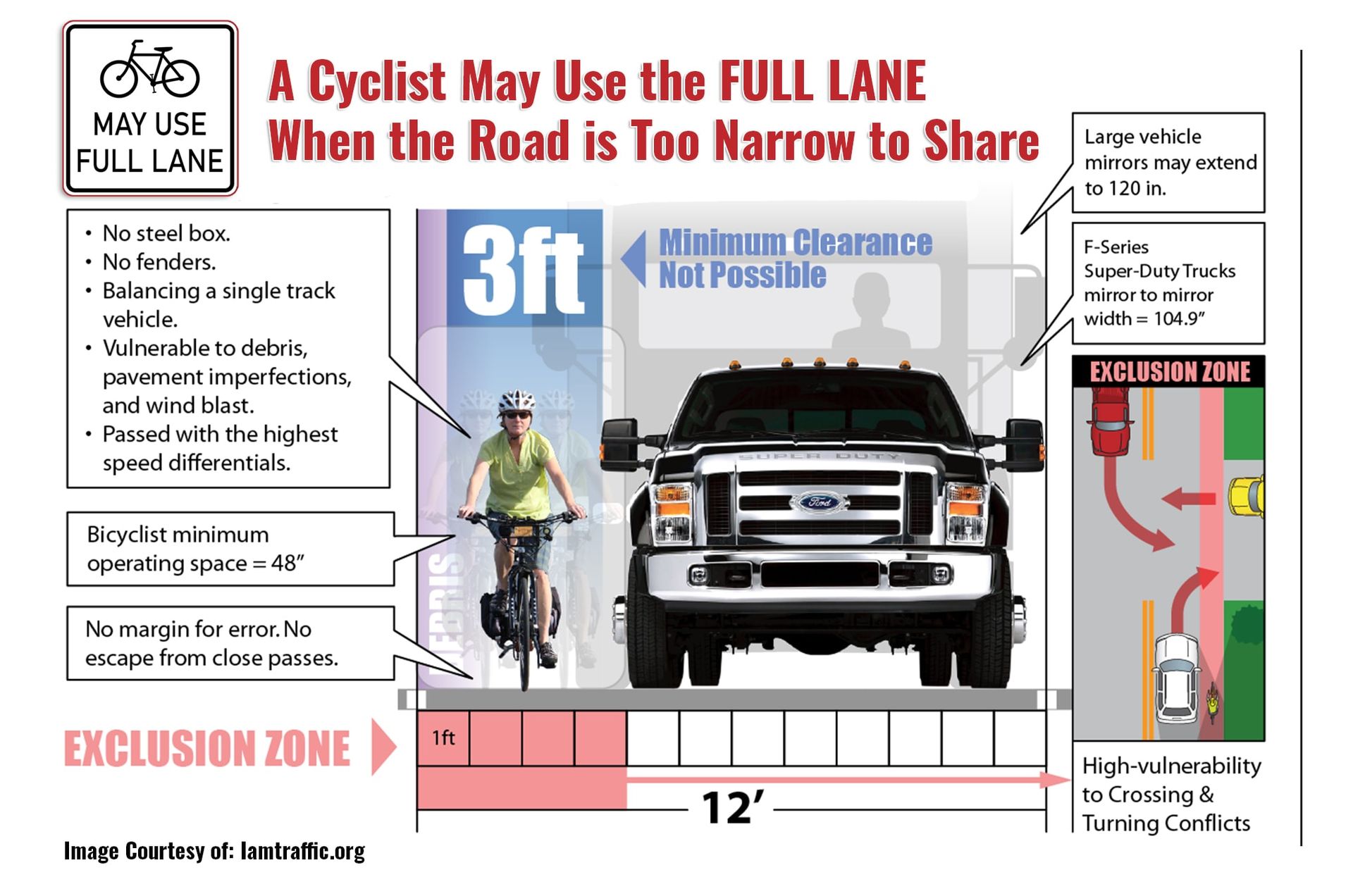
Sharing the road with large vehicles like trucks and buses can be intimidating for cyclists. These behemoths take up a lot of space and have significant blind spots, making them a major hazard for those on two wheels. But with some understanding and awareness on both sides, peaceful coexistence is possible.
The tight squeeze: Space constraints
One of the main challenges is the sheer size difference. Standard road lanes are often too narrow to accommodate both a large vehicle and a cyclist with a safe passing distance. Add in factors like road debris, parked cars, and uneven pavement, and the margin for error shrinks even further.
Safety first: Tips for sharing space
- Visibility is key: Wear bright clothing, use lights (even during the day), and make sure your bike has reflectors. The more visible you are, the better.
- Predict and react: Anticipate a truck's movements. They might need to swing wide to make a turn, so give them plenty of room.
- Don't Linger in blind spots: Large vehicles have significant blind spots on all sides. If you can't see the driver's face in their mirror, assume they can't see you.
- Communication is key: Make eye contact with drivers whenever possible, and use hand signals to indicate your intentions.
A call for better design
Ultimately, the safest solution is better road design. Wider lanes, dedicated bike lanes, and protected intersections can all make a significant difference in creating a safer environment for cyclists and drivers alike.
Bigger Vehicles, Smaller Space
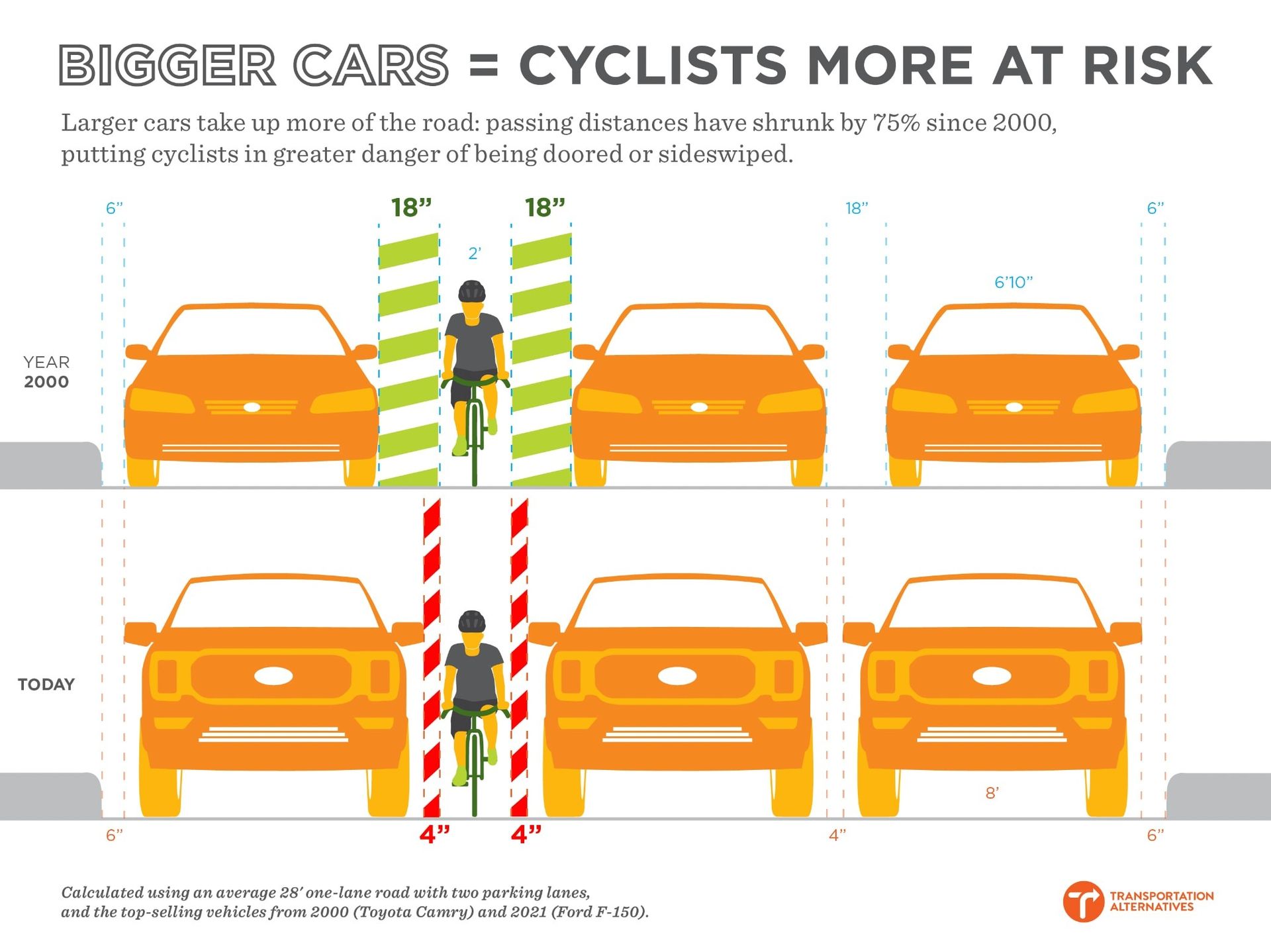
In recent years, vehicles have been getting bigger and bigger. This trend creates additional challenges for cyclists, as larger vehicles need more space to maneuver and have even larger blind spots.
This growing discrepancy between vehicle size and road infrastructure raises concerns about the feasibility of safe sharing. As vehicles continue to grow, it becomes increasingly important to advocate for infrastructure changes that prioritize the safety of vulnerable road users like cyclists.
Crossing the Line: When is it Legal to Pass a Cyclist?
One common question is whether drivers can cross a double yellow line to give a cyclist the required space. The answer depends on the specific laws in your state.
Double yellow lines: A general rule
In most cases, crossing a double yellow line to pass any vehicle is illegal and can result in a ticket. This is because double yellow lines indicate that passing is prohibited due to limited visibility or other safety concerns.
Exceptions for cyclists
However, some states have exceptions for passing cyclists. These exceptions typically allow drivers to cross a double yellow line if:
- It's safe to do so: There's no oncoming traffic or other hazards.
- There's enough space: The maneuver can be completed without endangering the cyclist or other road users.
- The cyclist is traveling at a slower speed: This typically means a speed significantly below the marked speed limit.
It's crucial to check your state's specific laws to understand the rules regarding crossing lines to pass cyclists. If you're unsure, it's always best to err on the side of caution and wait for a safe opportunity to pass without crossing the line.
The Importance of Patience: Why Drivers Should Wait to Safely Pass Cyclists
One of the fundamental aspects of road safety, especially when it comes to interactions between motorists and cyclists, is the practice of patience. The necessity for drivers to wait until it is safe to pass a cyclist, ensuring a minimum of a three-foot buffer, cannot be overstated. This practice is crucial not only for the safety of cyclists but also for the overall flow and temperance of traffic on our roads.
Reducing the Risk of Collisions
Adequate space while passing reduces the risk of sideswipe collisions and prevents the handlebars of a bicycle from getting clipped by a vehicle’s mirror—a common and dangerous occurrence when passing too closely. Moreover, the turbulence created by a vehicle, especially at high speeds, can destabilize a bicycle. Maintaining a safe distance minimizes this air disturbance and allows cyclists to maintain control.
Arguments Against Safe Passing Laws
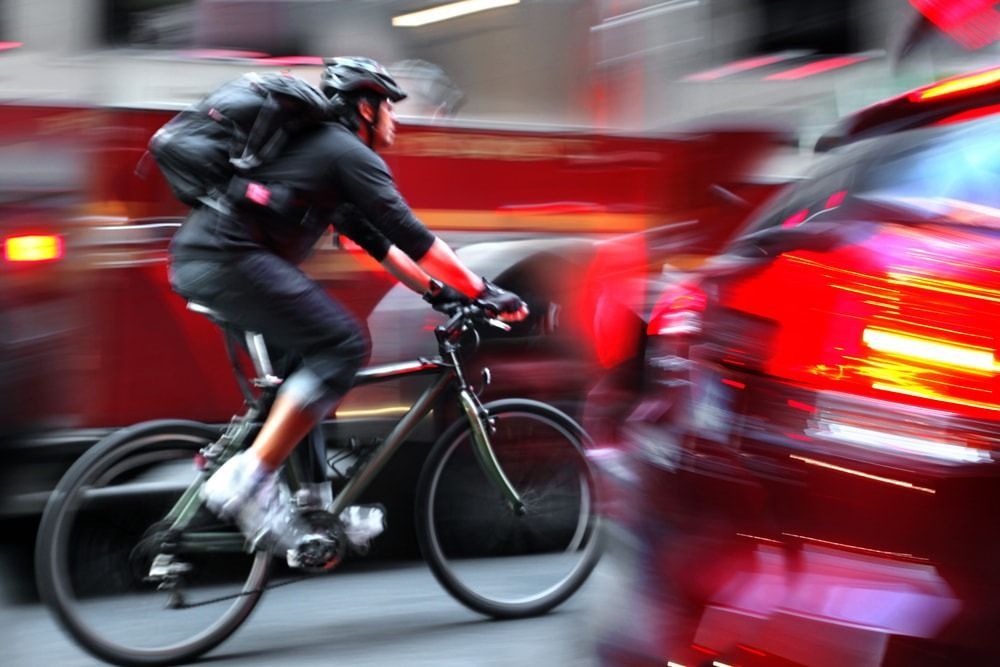
Despite the benefits, safe passing laws aren't without their critics. Let's take a look at some of the common arguments against these laws and the counterpoints from safety advocates.
Argument: "Laws don't change behavior."
Some argue that laws alone won't change driver behavior, and that education and infrastructure improvements are more effective.
- Counterpoint: While education and infrastructure are important, laws provide a legal framework to hold reckless motor vehicle drivers accountable. They also raise awareness and encourage safer driving practices.
Argument: "The laws are difficult to enforce."
Critics point out that it can be challenging for law enforcement to witness and enforce safe passing violations.
- Counterpoint: While enforcement is not always easy, technology like bike-mounted cameras and increased police patrols can help. Additionally, the deterrent effect of potential penalties can influence driver behavior.
Argument: "More bike lanes are the solution."
Some argue that instead of focusing on passing laws, resources should be directed towards building more dedicated bike lanes with adequate buffer zones.
- Counterpoint: While better bike lanes are undeniably beneficial, they aren't a universal solution. Many roads lack the space for bike lanes, and cyclists still need protection on roads shared with motor vehicles. Safe passing laws provide an additional layer of security in these situations.
A balanced perspective
It's important to consider both the benefits and criticisms of safe passing laws. While they may not be a perfect solution, they are crucial in promoting cyclist safety, raising awareness, and encouraging responsible driving behavior. The debate highlights the need for a multifaceted approach that combines legislation, education, and infrastructure improvements to create safer roads for everyone.
A Global Look at Safe Passing: How the U.S. Stacks Up
The U.S. isn't alone in recognizing the need to protect cyclists on the road. Many countries around the world have implemented their own safe passing laws, often with some key differences from the American approach. Let's take a quick trip around the globe to see how other countries are tackling this issue.
Europe: A leader in cyclist safety
Europe is often considered a leader in cyclist safety, with many countries boasting comprehensive bike infrastructure and robust legal protections.
- Minimum passing distances: Many European countries have specific minimum passing distances, often ranging from 1 meter (3.3 feet) to 1.5 meters (4.9 feet) or more. Some countries even adjust the required distance based on the speed of the passing vehicle.
- Lane change requirements: Similar to California's Omni Bike Law, some European countries require drivers to change lanes when passing a cyclist if it's safe to do so.
- Vulnerable road user laws: Some countries have broader "vulnerable road user" laws that offer enhanced protection to cyclists, pedestrians, and other vulnerable groups.
Australia: "Meter Matters" campaign
Australia has been a pioneer in promoting safe passing distances for cyclists. Their "Meter Matters" campaign emphasizes the importance of giving cyclists at least one meter (3.3 feet) of space when passing. This campaign has been successful in raising awareness and influencing driver behavior.
Other notable examples
- Canada: Many provinces have adopted minimum passing distance laws, with some requiring up to 1 meter (3.3 feet) of space.
- Japan: While there isn't a specific nationwide law, some local governments have implemented safe passing ordinances.
- South Africa: The country has a "1.5 Meter Matters" campaign similar to Australia's initiative.
The U.S. in perspective
While the U.S. has made progress with the 3-foot law and other safe passing measures, it still lags behind some other countries in terms of the scope and stringency of cyclist protection laws. However, the growing adoption of the 3-foot law and the recent changes in California's Omni Bike Law signal a positive trend toward increased cyclist safety.
By looking at how other countries approach safe passing, we can gain valuable insights and ideas for improving cyclist safety in the U.S.
State-by-State Variations in Safe Passing Laws Across the US

In the United States, safe passing laws aimed at protecting cyclists vary significantly from state to state, reflecting diverse approaches to road safety. Understanding these variations is essential for both cyclists and drivers to ensure compliance and enhance safety. Here's an overview of how these laws differ across the country.
Standard Three-Foot Laws
The majority of states have enacted the "three-foot law," which mandates that drivers must maintain a minimum distance of three feet when passing a cyclist. This rule is the baseline in states like Colorado, Georgia, and Ohio. It is designed to provide a clear and enforceable guideline to promote safety on the roads.
Greater Distances Required
Some states have decided that three feet is not sufficient under all circumstances and have enacted laws requiring greater distances. For example, Pennsylvania requires four feet of clearance when passing a cyclist, acknowledging that larger buffers can provide increased safety for cyclists, especially on roads where vehicle speeds are higher.
Complete Lane Change Laws
Several states, including California and Delaware, have implemented laws requiring that drivers change lanes to pass cyclists if another lane is available and it is safe to do so. This approach is considered to provide the highest level of safety, eliminating close interactions between vehicles and bicycles.
“Move Over” or Lane Vacating Laws
Similar to laws requiring drivers to move over for emergency vehicles, some states have specific provisions that require drivers to vacate the lane next to a cyclist completely when passing, if the road has multiple lanes in the same direction. This is particularly common in states with high cycling populations and aims to reduce the risk of accidents significantly.
Safe Distance Laws
Rather than specifying a precise measurement, some states employ a "safe distance" law without a defined numerical buffer. States like Arizona use this more flexible approach, which can be beneficial in varying traffic conditions but may also lead to inconsistencies in enforcement and interpretation.
Variations in Penalties and Enforcement
The enforcement of safe passing laws and the penalties for violations also differ widely. Some states impose hefty fines and add points to the driver’s license, while others may have more moderate penalties. Enforcement practices can vary significantly even within states, depending on local policies and the presence of cycling communities.
Exemptions and Specific Conditions
Certain states have exemptions or specific conditions under which the safe passing laws can be relaxed. For example, in narrow rural roads where the roadway width does not safely allow for a three-foot buffer, drivers may be permitted to pass with less clearance, provided they do so at a very reduced speed and with great caution.
No Specific Safe Passing Law
A few states still do not have a specific safe passing law that references bicycles. In these states, general traffic safety laws apply, and cyclists' safety largely depends on broader traffic enforcement and the discretion of individual drivers.
Do Safe Passing Laws Really Work? The Numbers Tell a Story
We've talked a lot about safe passing laws, but do they actually make a difference? The short answer is yes. Studies have shown that these laws can have a measurable impact on cyclist safety.
Before and after: A look at the data
When states implement safe passing laws, we often see a decrease in bicycle accidents and injuries. For example, a study in Minnesota found a 23% reduction in bicycle crashes involving vehicle overtaking after the state adopted a 3-foot passing law.
Other studies have shown similar trends, with reductions in both the frequency and severity of bicycle accidents. This suggests that safe passing laws are effective in promoting safer interactions between cyclists and drivers.
Safety in numbers: The impact on cyclist behavior
Interestingly, safe passing laws don't just affect driver behavior – they can also influence how cyclists ride. Research suggests that when cyclists feel safer due to legal protections, they are more likely to ride more often and for longer distances. This can lead to increased physical activity and improved overall health in communities with strong safe passing laws.
The need for more data
While the existing research is promising, there's still a need for more comprehensive studies to fully understand the impact of safe passing laws. Factors like law enforcement, public awareness, and road infrastructure can all influence the effectiveness of these laws. Ongoing research and data collection will help refine these laws and make them even more effective in protecting cyclists.
Upholding the Law: Challenges of Enforcing Safe Passing Rules
Even the best laws are useless if they're not enforced. Unfortunately, enforcing safe passing laws can be a challenge for law enforcement agencies.
Challenges on the road
- Limited resources: Police departments often have limited resources and can't dedicate officers solely to enforcing safe passing laws.
- Visibility issues: Unlike speeding or running a red light, unsafe passing can be difficult to witness and document.
- Driver education: Many drivers are still unaware of safe passing laws or don't fully understand their importance.
Strategies for enforcement
Despite the challenges, there are several strategies that can help improve enforcement:
- Targeted patrols: Police departments can focus patrols on areas with high cycling traffic or a history of unsafe passing incidents.
- Public awareness campaigns: Educating both drivers and cyclists about the laws and the importance of safe passing can encourage compliance.
- Collaboration: Law enforcement agencies can partner with cycling advocacy groups to raise awareness and gather data on unsafe passing incidents.
Pro tip: If you're a cyclist, consider investing in a bike-mounted camera. This can provide valuable evidence in the event of an accident and help ensure that negligent drivers are held accountable. And if you do find yourself in a legal battle, Bike Legal's experienced attorneys are ready to fight for your rights and help you secure the compensation you deserve.
Breaking the Law: The Price of Unsafe Passing
So, what happens if you're a driver who ignores the 3-foot law or other safe passing rules? The consequences can vary depending on the state, but they generally include:
- Fines: Drivers can be fined for violating safe passing laws. The amount of the fine varies by state and can increase for repeat offenses.
- Points on license: In some states, points may be added to the driver's license, which can lead to higher insurance rates or even license suspension.
- Civil liability: If an accident occurs, the driver who violated the law could be held liable for the cyclist's injuries and damages.
High-Tech Help: Gadgets for Safer Cycling
Technology is stepping up to make sharing the road safer for everyone. From radar systems that warn drivers about nearby cyclists to smart bike lights that alert riders of approaching vehicles, these innovations are changing the game.
Cars that see you: radar technology
Many newer cars come equipped with advanced driver-assistance systems (ADAS) that include radar technology. These systems can detect cyclists in your blind spots or approaching from behind, alerting you with visual or audible warnings.
Some systems even apply automatic braking if they sense an impending collision. While these features are no substitute for safe driving practices, they can provide an extra layer of protection.
Radar for cyclists
Radar isn't just for cars anymore. Bike-mounted radar systems like the Garmin Varia can detect vehicles approaching from behind and alert you with a visual or audible signal. This gives you a heads-up so you can adjust your position.
Smart bike lights: More than just illumination
Smart bike lights are taking safety to the next level. Some models can automatically adjust their brightness based on ambient light conditions, while others can even detect deceleration and flash brighter to warn drivers.
These lights make you more visible and provide an extra layer of communication with drivers, helping prevent accidents.
Rethinking Roads: Design for Safer Cycling
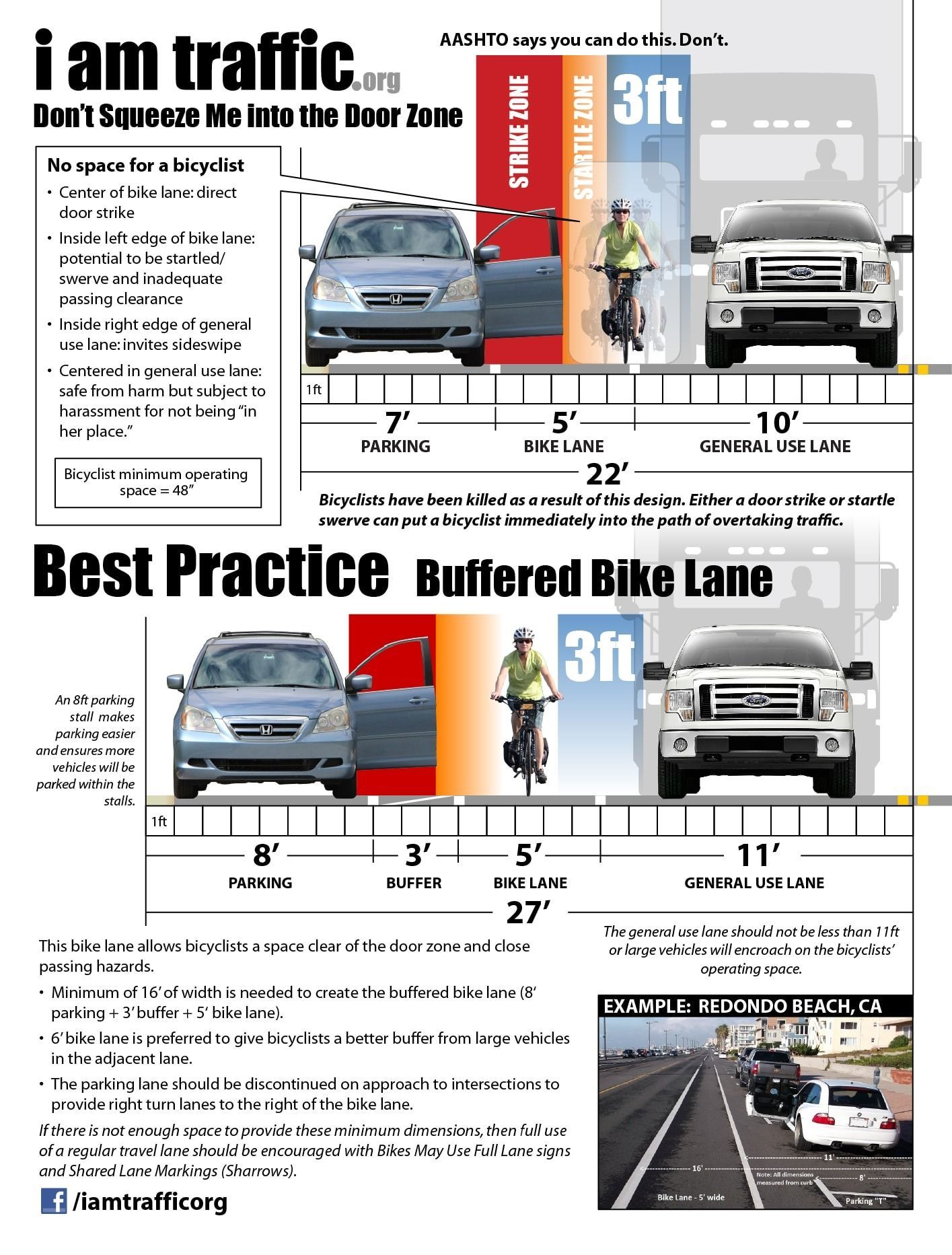
Beyond gadgets, the way our roads are designed plays a huge role in cyclist safety. Let's explore some key considerations.
The great road debate: Wider or not?
Some argue that widening roads is the key to safer cycling. The idea is that wider roads provide more space for cars and bikes to coexist, reducing the risk of close passes and collisions.
However, others argue that wider roads simply encourage drivers to go faster, which can actually increase the risk of accidents. They advocate for narrower roads with lower speed limits, which create a more calming and predictable traffic environment.
Urban planning: A holistic approach
The best solution likely lies somewhere in the middle. Urban planners are increasingly taking a more holistic approach to road design, considering the needs of cars and the safety of cyclists and pedestrians.
This includes creating dedicated bike lanes, protected intersections, traffic calming measures, and other infrastructure improvements that prioritize safety for all road users.
Buffered Bike Lanes: Your Personal Safety Zone
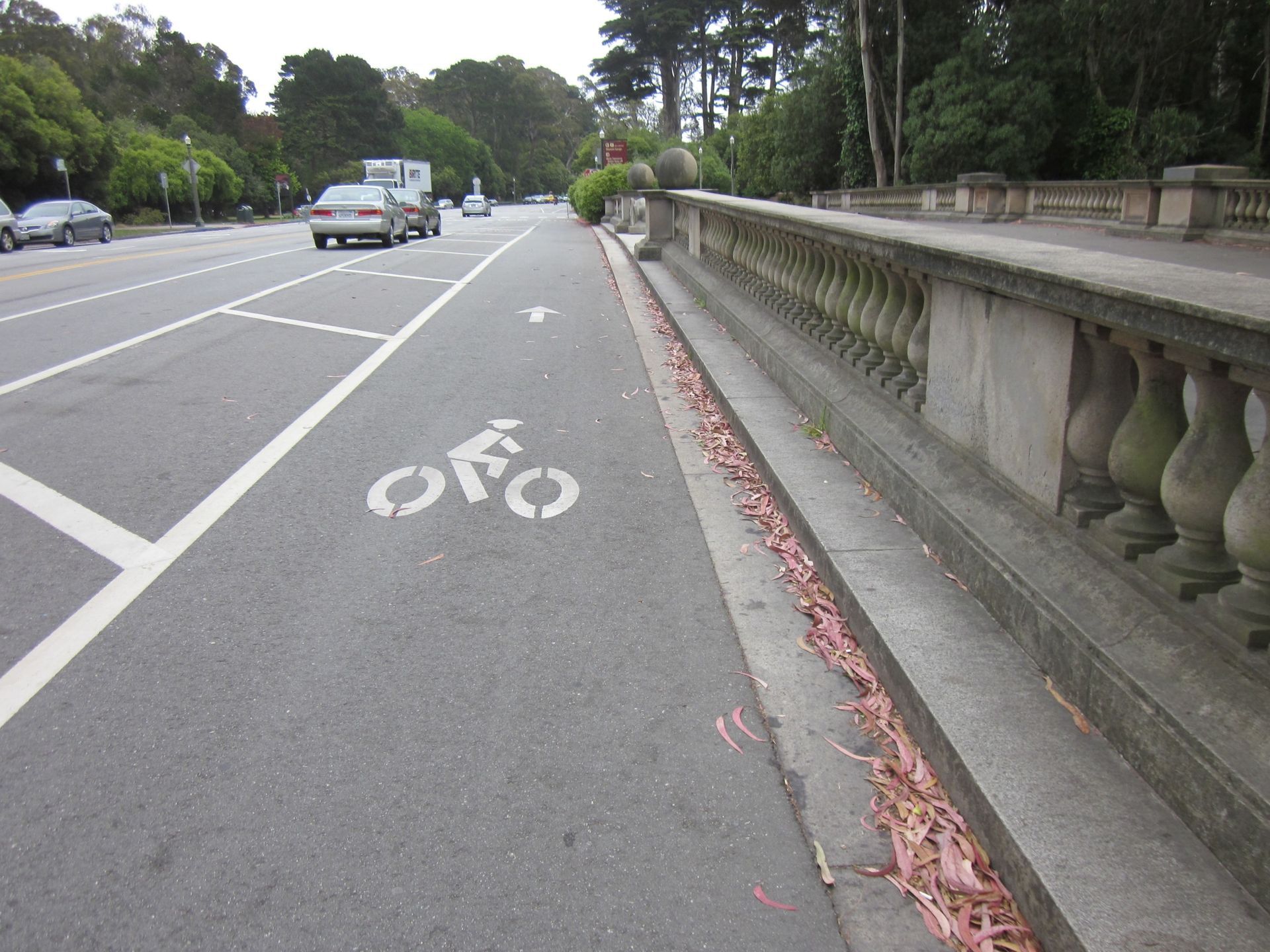
One of the most effective solutions for safer cycling is the buffered bike lane. These lanes provide a dedicated space for cyclists, separated from traffic by a buffer zone.
How they work
Buffered bike lanes are wider than standard bike lanes and include a painted buffer zone between the bike lane and the traffic lane. This buffer zone creates a physical barrier that discourages drivers from encroaching on the bike lane.
Why they're effective
Buffered bike lanes have been shown to significantly reduce accidents and injuries for cyclists. They offer several key advantages:
- Increased visibility: The buffer zone makes cyclists more visible to drivers, reducing the risk of being overlooked.
- Reduced conflict: The buffer creates a clear separation between bikes and cars, minimizing the potential for collisions.
- Enhanced comfort: Cyclists feel safer and more comfortable riding in a dedicated space with a buffer zone.
More is better: The need for more bike lanes
While buffered bike lanes are ideal, even standard bike lanes can make a big difference. Studies have shown that the presence of any bike lane can reduce the risk of cyclist injuries by up to 50%.
The key is to prioritize cycling infrastructure and create a network of connected bike lanes that allow cyclists to travel safely throughout their communities.
Ride Confidently with Bike Legal in Your Corner
Understanding the 3-foot law and other safe passing laws is a crucial step in protecting yourself as a cyclist. Knowing your rights and responsibilities allows you to ride confidently and advocate for a safer cycling environment.
Here's a quick recap of what we've covered:
- The 3-foot law requires drivers to give you at least three feet of space when a motorist passing by in the same direction.
- Other laws offer even greater protection, with wider passing distances or lane change requirements.
- Safe passing laws have a proven track record of reducing accidents and injuries.
- Technology and road design innovations are making cycling safer.
- The debate over the ideal passing distance continues, but prioritizing safety is paramount.
Sharing the road is a two-way street. By staying informed, advocating for safer infrastructure, and promoting a culture of mutual respect, we can all work together to create a more harmonious and safer environment for cyclists and drivers alike.
If you've been injured in a bicycle accident, remember that you don't have to navigate the legal process alone. Bike Legal is here to provide expert guidance and fight for your rights. We understand the unique challenges cyclists face, and we're committed to helping you get the justice and compensation you deserve.


